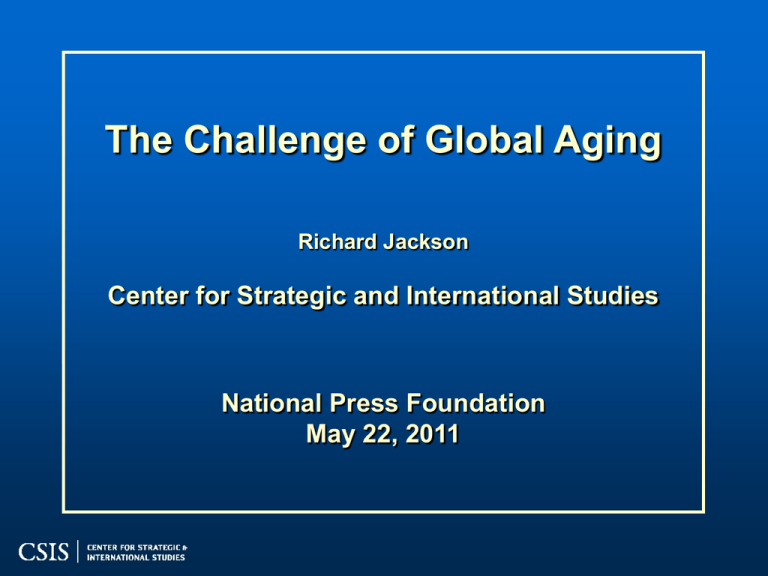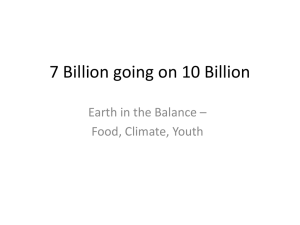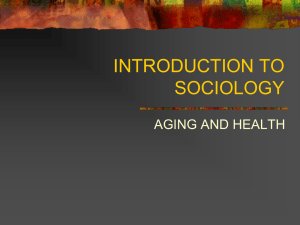Challenge of Global Aging - National Press Foundation
advertisement

The Challenge of Global Aging Richard Jackson Center for Strategic and International Studies National Press Foundation May 22, 2011 Part I The Demographic Transformation The world is on the cusp of a stunning demographic transformation. Elderly (Aged 65 and Over), as a Percent of the Population in 2010 and 2050 4.9% India 2010 13.5% Mexico 6.3% Brazil 7.0% 2050 16.9% 13.1% Australia 13.4% 16.6% 24.4% Italy 18.2% 25.2% S.Korea 16.8% France 10% 20% 30% 14.1% 26.0% 20.4% 33.7% 17.0% 35.1% 20.4% 35.4% 11.1% 36.1% 22.7% Japan 25.3% 0% 25.6% Spain 23.5% Sweden 12.8% Russia Germany 21.3% UK 25.4% Canada 20.8% US 8.2% China 40% 50% 38.7% 0% 10% 20% 30% 40% 50% Source: UN (2011) Behind the Global Age Wave: Falling Fertility Total Fertility Rate G-7 Countries Major Emerging Markets 1960-65 1980-85 2005-10 1960-65 1980-85 2005-10 Canada 3.7 1.6 1.7 Brazil 6.2 3.8 1.9 France 2.8 1.9 2.0 China 5.6 2.6 1.6 Germany 2.5 1.5 1.4 India 5.8 4.5 2.7 Italy 2.5 1.5 1.4 Indonesia 5.6 4.1 2.2 Japan 2.0 1.8 1.3 Mexico 6.8 4.3 2.4 UK 2.8 1.8 1.8 Russia 2.6 2.0 1.4 US 3.3 1.8 2.1 S. Korea 5.6 2.2 1.3 Source: UN (2011) Behind the Global Age Wave: Rising Life Expectancy Life Expectancy at Birth G-7 Countries Major Emerging Markets 1950-55 1980-85 2005-10 1950-55 1980-85 2005-10 Canada 69.0 75.8 80.5 Brazil 50.9 63.4 72.2 France 67.3 74.8 81.0 China 44.6 67.7 72.7 Germany 67.5 73.8 79.8 India 37.9 56.2 64.2 Italy 66.3 74.8 81.4 Indonesia 38.8 58.8 67.9 Japan 62.2 76.9 82.7 Mexico 50.7 67.7 76.2 UK 69.3 74.1 79.6 Russia 64.5 67.4 67.7 US 68.6 74.3 78.0 S. Korea 47.9 67.4 80.0 Source: UN (2011) Part II The Broad Economic, Social, and Geopolitical Implications Fiscal Burden CSIS “Current Deal” Projection: Government Old-Age Benefits, as a Percent of GDP, 2007–2050 Public Pensions 2007 2030 2050 Health Benefits 2007 2030 2050 Total 2007 2030 2050 Canada 3.9% 7.0% 8.4% 3.6% 6.1% 8.9% 7.5% 13.1% 17.3% France 11.2% 17.8% 19.6% 4.5% 7.8% 10.2% 15.6% 25.6% 29.8% Germany 10.0% 17.0% 20.4% 4.1% 6.3% 8.5% 14.1% 23.3% 28.9% Italy 12.3% 18.9% 24.6% 3.4% 5.5% 7.5% 15.7% 24.4% 32.1% Japan 9.1% 13.9% 19.3% 4.0% 6.0% 8.0% 13.2% 19.9% 27.3% UK 5.8% 7.9% 8.5% 4.0% 6.3% 8.8% 9.8% 14.2% 17.3% United States 4.1% 6.6% 7.0% 4.2% 8.0% 10.2% 8.3% 14.6% 17.2% Developed World 8.8% 13.7% 16.6% 3.8% 6.3% 8.6% 11.2% 17.9% 22.5% Note: Old-age benefits are benefits to persons aged 60 and over. Pension projections assume retirement ages remain unchanged and benefits continue to replace the same share of wages they do today. Source: The Global Aging Preparedness Index (CSIS, 2010) Fiscal Burden Few countries will be able to raise taxes enough to cover more than a fraction of the age wave’s cost. Most will have to cut benefits—but the required adjustments are large and are likely to meet growing political resistance from aging electorates. The alternatives: cannibalize other public spending or let fiscal deficits grow. Public Benefits in 2007, as a Percent of Total Elderly Cash Income Average 3rd Quintile Canada 31% 47% France 59% 72% Germany 47% 76% Italy 55% 77% Japan 39% 61% UK 42% 69% US 22% 38% Note: The elderly are persons aged 60 and over. Source: The Global Aging Preparedness Index (CSIS, 2010) Fiscal Burden Projected Growth in Major U.S. Entitlement Programs* versus Current Discretionary Spending and Individual Income Taxes, as a Percent of GDP 20% 16% 12% 18.1% Growth 2010-40: 7.8% 10.3% 8% 7.6% 7.8% 2000-2010 Average 2000-2010 Average 4% 0% 2010 2040 Major Entitlement Programs* Discretionary Spending Individual Income Taxes * CBO “Alternative Fiscal Scenario.” Includes Social Security, Medicaid, Medicare, Exchange Subsidies, and CHIP outlays. Source: CBO (2010) 9 Economic Growth The slowdown in workforce growth in the developed world will translate into slower growth in GDP. Average Annual Growth Rate in the Working-Age Population (Aged 20-64), by Decade 1980s 1990s 2000s 2010s 2020s 2030s 2040s Japan and some faster-aging European countries face a future of secular stagnation. Productivity and living standard growth may also slow as rates of saving and investment decline. Aging workforces may be less flexible, less mobile, and less entrepreneurial—putting a further drag on economic growth. Stagnant or contracting markets will increase the risk of “beggarthy-neighbor” protectionism. Canada 1.7% 1.1% 1.2% 0.5% 0.0% 0.2% 0.1% France 1.0% 0.4% 0.6% -0.2% -0.1% -0.2% 0.0% Germany 1.1% 0.2% -0.2% -0.3% -1.2% -1.2% -0.9% Italy 0.9% 0.2% 0.3% -0.3% -0.6% -1.2% -0.9% Japan 0.7% 0.4% -0.4% -1.0% -0.7% -1.5% -1.5% UK 0.6% 0.4% 0.6% 0.3% 0.0% 0.1% 0.3% US 1.4% 1.2% 1.1% 0.6% 0.3% 0.6% 0.6% Source: UN (2009) Social Mood As societies age, the overall social mood may become more risk averse and “small c” conservative. Smaller families may find it more difficult to socialize the young—and care for the old. Elder-dominated electorates may lock in current public spending commitments at the expense of new priorities. Even as societies age, they will also become more diverse—challenging social cohesion in some countries. 35% Share of Population with Less than 20 Years of Life Remaining, by Country, 1950-2050 30% Japan Italy 25% Germany UK 20% Canada France 15% US 10% 1950 1970 1990 2010 2030 2050 Source: CSIS calculations based on UN (2007) and Human Mortality Database, University of California, Berkeley and Max Planck Institute for Demographic Research Geopolitics The Developed World: A shrinking share of global population 25% Developed World Population by Region, as a Share of World Total, 1950-2050 Population as a Share of World Total 1950 2005 US 6.2% 4.6% Western Europe 9.6% 5.0% Japan 3.3% 2 .0% Other English-Speaking 3.1% 1.9% Countries 20% 2050 4.1% 3.1% 1.0% 1.4% 15% Japan 10% Other English-Speaking Countries Western Europe US 5% 0% 1950 1960 1970 1980 1990 2000 2010 2020 2030 2040 2050 Source: The Graying of the Great Powers (CSIS, 2008) Geopolitics The Developed World: A shrinking share of global GDP 70% Developed World GDP (in 2005 PPP Dollars), as a Percent of World Total, 1950-2050 GDP as a Share of World Total 1950 2005 2050 US 29.1% 22.3% 16.9% Western Europe 22.7% 17.4% 7.1% Japan 3.2% 6.9% 2.5% Other English-Speaking 9.2% 7.0% 4.5% Countries 60% 50% 40% 30% 20% 10% 0% 1950 Japan Other English-Speaking Countries Western Europe US 1960 1970 1980 1990 2000 2010 2020 2030 2040 2050 Source: The Graying of the Great Powers (CSIS, 2008) Geopolitics 12 Largest Countries Ranked by Population Ranking 1950 1 2 3 4 5 6 7 8 9 10 11 12 China India US Russian Federation Japan Indonesia Germany Brazil UK Italy Bangladesh France 2010 2050 China India US Indonesia Brazil Pakistan Bangladesh Nigeria Russian Federation Japan Mexico Philippines India China US Pakistan Nigeria Indonesia Bangladesh Brazil Ethiopia Philippines Dem. Rep. Congo Egypt Germany (16) France (21) UK (22) Italy (23) Russian Federation (16) Japan (19) UK (27) France (29) Germany (30) Italy (37) Source: UN (2009) Note: Rankings for developed countries that have fallen below 12 are in parentheses. The United States is better positioned to confront the age wave than most developed countries. The United States is now the youngest of the developed countries—and thanks to its relatively high fertility rate and substantial net immigration it is projected to remain the youngest. America’s flexible labor markets, broad and deep capital markets, and entrepreneurial culture also constitute important advantages. 60% U.S. Population and GDP (in 2005 PPP Dollars), as a Share of Developed World Total, 1950-2050 50% 40% 30% To be sure, the United States labors under some notable handicaps, including a low savings rate, an extraordinarily expensive health system, and a political culture that finds it difficult to make trade-offs. But among today’s developed countries, it alone will have the demographic and economic resources to play a major geopolitical role. GDP 20% Population 10% 0% 1950 1970 1990 2010 2030 Source: The Graying of the Great Powers (CSIS, 2008) 2050 Part III Aging and Health The Age-Related Health-Care Multiplier The elderly consume more per capita in healthcare services than the nonelderly. Ratio of Per Capita Health-Care Spending on the Elderly to Spending on the Nonelderly in Most Recent Year Available* Canada 4.9 France Germany Italy Japan Netherlands Spain Sweden UK US 3.0 2.7 3.2 4.9 3.9 3.2 2.8 3.4 3.7 •Data refer to public health-care spending, except for the United States, where they refer to total personal health-care spending. Source: OECD (2002); and Centers for Medicare & Medicaid Services (2007) The Age-Related Health-Care Multiplier The older the elderly are the more health care they consume. 35 Ratio of Per Capita U.S. Personal Health-Care Spending on the Elderly to Spending on the Nonelderly in 2004, by Elderly Age Group 31.8 30 Age 65 & Over 25 Age 65-74 20 Age 75-84 15 Age 85 & Over 10 5 10.4 9.9 2.7 2.3 3.1 3.5 3.7 0 Acute Care Source: Centers for Medicare & Medicaid Services (2007) Long-Term Care The Age-Related Health-Care Multiplier The oldest elderly age brackets will be the fastest growing of all. 600% Cumulative Percentage Change in the Elderly Population by Age Group, 2010–2050 526% 500% Age 65-74 400% Age 75-84 Age 85 & Over 300% 300% 225% 200% 114% 100% 124% 78% 0% US Source: UN (2011) China Other Drivers: “Excess Cost Growth” Per capita health-care costs for everyone are rising faster than per capita GDP. Behind excess cost growth: new technologies create new demand for medical services. Behind excess cost growth: “Good health” is a subjective standard that rises over time. Behind excess cost growth: As people become more knowledgeable about treatment options, limits are harder to set. Other Drivers: The changing shape of the family. Average Number of Surviving Children of the Elderly: 2007, 2040, and Change from 2007 to 2040 2007 2040 Change 2007 1 Sweden 2.1 2.0 -0.2 9 2 Japan 2.0 1.5 -0.5 3 UK 2.4 1.9 4 France 2.5 5 Germany 6 Change 2.9 1.9 -1.0 10 Australia 3.0 2.0 -1.0 -0.6 11 Spain 2.7 1.4 -1.2 1.9 -0.6 12 Canada 3.2 1.7 -1.5 2.1 1.4 -0.7 13 China 3.5 2.0 -1.6 Russia 2.2 1.5 -0.7 14 Brazil 3.8 2.1 -1.7 7 India 3.5 2.6 -0.9 15 Korea 3.6 1.8 -1.8 8 Italy 2.3 1.4 -0.9 16 Mexico 5.0 2.6 -2.5 Note: The elderly are persons aged 60 and over. Source: The Global Aging Preparedness Index (CSIS, 2010). US 2040 Two Models of Aging and Health The “compression of morbidity” model predicts that health spans will rise along with life spans. The “failure of success” model predicts that rising life spans will mean a rising incidence of chronic morbidity among the elderly. The Good News: Rates of elderly disability are declining. Percent of U.S Elderly with a Disability or in an Institution With a Disability 1982 1989 1999 2005 Age 65-74 14.2 11.9 10.7 8.9 Age 75-85 30.7 29.9 23.4 21.9 Age 85+ 62.1 61.4 55.6 49.7 In an Institution 1982 1989 1999 2005 Age 65-74 2 1.9 1.4 0.9 Age 75-85 8.1 7.0 4.3 4.1 Age 85+ 27.2 26.1 19.5 15.6 Source: Manton, Gu & Vicki (2006) The Bad News: Rates of elderly morbidity are flat or rising. Percent of U.S. Elderly with Selected Medical Conditions 1998-2000 2004-2006 2007-2009 Heart Disease Age 65-74 17.6 18.6 17.4 Age 75-84 22.2 24.8 24.6 Age 85+ 24.0 28.6 27.2 Stroke Age 65-74 6.5 6.9 6.3 Age 75-84 10.1 11.0 11.2 Age 85+ 10.4 15.1 13.8 Cancer Age 65-74 17.0 18.3 20.5 Age 75-84 21.8 25 25.9 Age 85+ 21.4 25 27.7 Diabetes Age 65-74 14.5 18.4 19.9 Age 75-84 13.4 17.6 19.0 Age 85+ 9.3 12.6 13.7 Source: NHIS (various years) We live in an era defined by many challenges, from global warming to global terrorism. None is as certain as global aging. And none is likely to have such a large and enduring effect on the shape of national economies and the world order. CSIS.ORG GAPINDEX.CSIS.ORG








